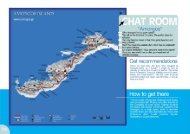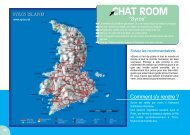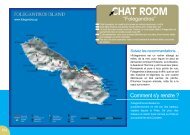Cyclades Guide - Escale Yachting
Cyclades Guide - Escale Yachting
Cyclades Guide - Escale Yachting
You also want an ePaper? Increase the reach of your titles
YUMPU automatically turns print PDFs into web optimized ePapers that Google loves.
Feathered visitors, land and sea<br />
inhabitants<br />
The islands of the <strong>Cyclades</strong> demonstrate a particularly interesting<br />
fauna which includes several endemic species only found in Greece,<br />
or even on only one island or islet!<br />
The <strong>Cyclades</strong> are home to several local endemic reptiles: the viper of<br />
Milos (Milos, Kimolos, Polyegos, Sifnos), the lizard of Milos (Milos,<br />
Antimilos, Kimolos), the little crocodile (Delos, Naxos, Paros,<br />
(bottlenose dolphin, pilot whale, Risso's dolphin).<br />
The sea fauna of the <strong>Cyclades</strong> is particularly rich,<br />
and includes more than 200 species of fish (red<br />
mullet, pandora, gilthead seabream, white<br />
seabream, saddled seabream, black seabream,<br />
meagre) and octopus, squid, cuttlefish, lobster<br />
and sea horses – a true paradise for underwater<br />
fishing and diving.<br />
8<br />
Antiparos, Mykonos), and the (most common) ratsnake, “lafiatis”.<br />
Among the mammals seen in <strong>Cyclades</strong>, significant are the rare wild<br />
goat only found in Antimilos, the Mediterranean seal (the most<br />
important mammal of the Aegean Sea), and various dolphin species<br />
Others were here before you…<br />
The most ancient settlement in the <strong>Cyclades</strong> dates back to 9000 BC, in<br />
Kythnos.










